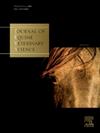临床健康马和咬马的夜间地塞米松抑制和皮质醇指数试验
IF 1.6
3区 农林科学
Q2 VETERINARY SCIENCES
引用次数: 0
摘要
背景:地塞米松抑制试验(DST)已在人类中用于诊断抑郁症、焦虑症和库欣综合征等精神问题,并在马中用于垂体中间部分功能障碍的死前诊断。目的:本研究旨在通过DST和皮质醇指数(CI)检测下丘脑-垂体-肾上腺轴的功能,以评估健康马咬马床或吸风时皮质醇昼夜节律周期的节律性。方法:选取20匹两性哥伦比亚克里奥尔马,在相似的管理条件和完整的马厩制度下,分为咬槽马(G1) (n=10)和不咬槽马(G2) (n=10)两组。分别于上午和下午采血测定CI,下午采血后立即建立DST方案。采用夹心ELISA法测定各组在地塞米松治疗后的血清皮质醇浓度。结果:两组血清皮质醇浓度相等(G1: 9.52±7.01µg/dl;G2: 8.4±5.30µg/dl), CI无差异,无论临床状况如何,所有动物的DST均为阳性。结论:DST和CI不能区分马是否咬槽。有必要在纵向研究中实施更精确的技术,并建立特定的参考值和截止点,以解释咬床病例的皮质醇抑制,伴随着其他激素,如促肾上腺皮质激素和促肾上腺皮质激素释放激素,由于其多因素性质和高皮质醇变异性。本文章由计算机程序翻译,如有差异,请以英文原文为准。
Overnight dexamethasone suppression and cortisol index tests in clinically healthy horses and with crib-biting
Background
The dexamethasone suppression test (DST) has been used in humans for the diagnosis of psychiatric problems such as depression, anxiety and Cushing's syndrome, and in horses for the ante mortem diagnosis of dysfunction of the intermediate part of the pituitary.
Aims/objectives
This study aimed to examine the functionality of the hypothalamic-pituitary-adrenal axis through the DST and the cortisol index (CI), to evaluate the rhythmicity of the circadian cycle of cortisol in healthy horses with crib-biting or windsucking.
Methods
A total of 20 Colombian Creole horses of both sexes, under similar management conditions and a complete stabling system, formed two study groups: crib-biting horses (G1) (n = 10) and non-crib-biting horses (G2) (n = 10). Blood samples were taken in the morning and afternoon to determine the CI, and immediately after collection in the afternoon, the DST protocol was established. The serum cortisol concentration was determined through sandwich ELISA at all established times and after dexamethasone treatment for each group.
Results
Serum cortisol concentrations were equal in both groups (G1: 9.52 ± 7.01 µg/dl; G2: 8.4 ± 5.30 µg/dl), with no difference in CI, and DST was positive in all animals regardless of their clinical condition.
Conclusion
The DST and the CI did not distinguish horses with and without crib-biting. It is necessary to implement techniques with greater precision in longitudinal studies and establish specific reference values and cutoff points for the interpretation of cortisol suppression for cases of crib-biting, accompanied by other hormones such as adrenocorticotropic hormone and corticotropin-releasing hormone, owing to their multifactorial nature and high cortisol variability.
求助全文
通过发布文献求助,成功后即可免费获取论文全文。
去求助
来源期刊

Journal of Equine Veterinary Science
农林科学-兽医学
CiteScore
2.70
自引率
7.70%
发文量
249
审稿时长
77 days
期刊介绍:
Journal of Equine Veterinary Science (JEVS) is an international publication designed for the practicing equine veterinarian, equine researcher, and other equine health care specialist. Published monthly, each issue of JEVS includes original research, reviews, case reports, short communications, and clinical techniques from leaders in the equine veterinary field, covering such topics as laminitis, reproduction, infectious disease, parasitology, behavior, podology, internal medicine, surgery and nutrition.
 求助内容:
求助内容: 应助结果提醒方式:
应助结果提醒方式:


